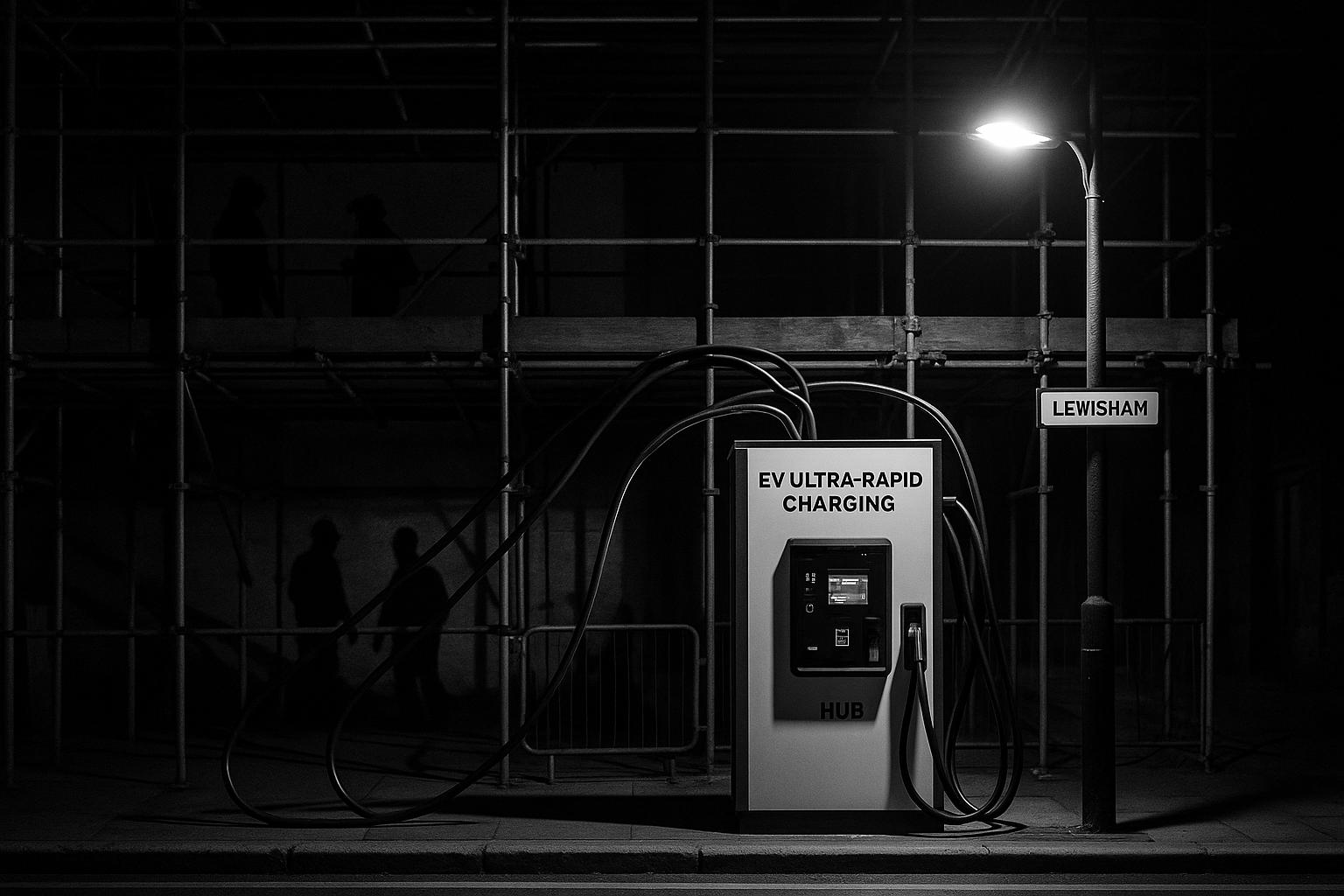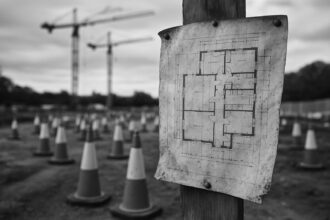Hubber, founded by three former members of Tesla’s UK Supercharger team, has secured £60m in equity to build 30 modular, planning‑approved high‑power charging hubs across major UK cities, starting with a Lewisham site due to open 20 August 2025 aimed at fleets and other urban operators.
Hubber, a start‑up founded by three former members of Tesla’s UK Supercharger team, has raised £60 million in equity to build a network of high‑powered urban EV charging hubs aimed at commercial fleets. According to the company, the first site will open in Lewisham on 20 August 2025 and will act as a blueprint for a planned roll‑out of 30 modular, planning‑approved hubs across major UK cities designed to deliver roughly 100MW of grid capacity for on‑shift charging. The investment is intended to accelerate deployments in dense urban areas where home charging is scarce and fleet demand is growing rapidly.
The leadership team—Harry Fox, Connor Selwood and Hugh Leckie—brings hands‑on delivery experience from the Supercharger and ultra‑rapid roll‑outs they led at Tesla in the UK. The founders say they previously oversaw more than 100 Supercharger sites and some 1,200 ultra‑rapid charge points, experience they have repurposed into Hubber’s site‑selection and turnkey delivery model. Industry reporting also notes that Tesla’s internal Supercharger division was disbanded in April 2024, which helps explain why several veteran members of that team have moved into independent infrastructure ventures.
Investor backing has been led by James Bayliss, formerly head trader at Elliott Advisors (UK), with participation from Christopher Fox, previously CFO of the British Business Bank. Hubber says the £60 million will fund its proprietary site‑selection technology, commercial deal structuring and the initial tranche of 30 hubs that together aim to unlock megawatt‑scale grid connections. The company emphasises speed and repeatability in converting under‑utilised urban real estate into operational charging and energy hubs.
Hubber’s first Lewisham hub is being developed in partnership with RAW Charging, a destination charge‑point operator that recently received significant growth capital and a controlling stake investment to expand its national footprint. RAW’s backers have signalled ambitions to accelerate roll‑out of destination chargers at retail, leisure and hospitality sites, providing a complementary route to market for Hubber’s urban‑facing hub locations.
The need for such infrastructure is widely documented. Research cited by ride‑hailing platforms shows charging access has overtaken vehicle purchase cost as the main barrier for drivers considering EVs, and only a minority of drivers in the UK have access to home charging. That combination makes fast, reliable kerbside and depot‑adjacent charging a critical bottleneck for taxis, ride‑hail fleets and delivery vehicles that must recharge between shifts to remain operational.
Hubber describes its offering as a specialist real‑estate and delivery platform that converts under‑used urban property into ultra‑rapid charging and energy hubs, with a focus on modular designs and planning certainty. The company says its model removes many of the barriers faced by charge‑point operators and fleets—chiefly site availability, planning complexity and the challenge of securing multi‑megawatt grid connections in dense city environments.
Public records confirm Hubber’s corporate status: Companies House filings show Hubber Infrastructure Limited was incorporated in July 2024 and list named officers, providing formal validation of the company’s legal establishment and governance filings required for large infrastructure deployments in the UK.
Delivering 100MW of distributed urban capacity and 30 active hubs will not be straightforward. Developers must secure sites, negotiate commercial terms with landlords and retailers, obtain planning consent, and coordinate complex grid reinforcement works with distribution network operators. These are known pinch points for any rapid roll‑out of megawatt‑scale urban charging and will determine how quickly Hubber’s stated ambitions can be realised in practice.
Hubber’s chief executive, Harry Fox, told EV Infrastructure News that “the fleets doing the most miles—taxis, ride‑hail, delivery vans, buses—are electrifying fast, yet city infrastructure is lagging,” and argued that “large, high‑powered hubs are the key to enabling continuous, efficient and scalable operations.” Investor James Bayliss added in the same interview that the funding gives the team the capital to tackle what he described as “one of the UK’s biggest infrastructure challenges.”
If Hubber can translate its technical know‑how and new capital into workable sites, the company could ease a pressing constraint on urban electrification. At the same time, progress will depend on effective partnerships with charge‑point operators, real‑estate owners, network operators and local authorities—and on transparent delivery milestones that allow independent scrutiny of how quickly the promised 30 hubs and 100MW of capacity appear on the ground. RAW’s recent growth funding underlines the scale of ambition among operators, but the practicalities of planning, grid reinforcement and commercial contracting will determine whether that ambition becomes reality.
 Reference Map:
Reference Map:
Reference Map:
- Paragraph 1 – [1], [3]
- Paragraph 2 – [1], [4], [3]
- Paragraph 3 – [1], [2], [3]
- Paragraph 4 – [1], [6]
- Paragraph 5 – [1], [7]
- Paragraph 6 – [3], [1]
- Paragraph 7 – [5]
- Paragraph 8 – [1], [3], [4]
- Paragraph 9 – [1]
- Paragraph 10 – [6], [1]
Source: Noah Wire Services
- https://www.evinfrastructurenews.com/ev-networks/hubber-ex-tesla-fleet-charging-60m-investment – Please view link – unable to able to access data
- https://www.evinfrastructurenews.com/ev-networks/hubber-ex-tesla-fleet-charging-60m-investment – EV Infrastructure News reports Hubber, founded by three former Tesla UK employees, has secured £60 million in equity to build high-powered urban EV charging hubs. The article states Hubber will open its first Lewisham site on 20 August and aims to roll out 30 modular hubs across UK cities to provide 100MW of grid capacity. It identifies founders Harry Fox, Connor Selwood and Hugh Leckie and highlights their prior delivery of Tesla Supercharger and ultra‑rapid chargers. The report notes the Lewisham hub partnership with RAW Charging and names investors led by James Bayliss alongside Christopher Fox to scale electrification efforts.
- https://hubber-infra.co.uk/ – Hubber’s official site describes the company as a specialist real estate platform founded by an ex‑Tesla team that converts underutilised urban property into ultra‑rapid EV charging and energy hubs. It outlines a mission to enable cleaner, smarter cities by delivering modular, planning‑approved charging sites that remove barriers for charge point operators and fleets. The team page lists Harry Fox as co‑founder and CEO, with Connor Selwood and Hugh Leckie as co‑founders. The site highlights the focus on megawatt‑scale grid connections, fleet electrification and reducing urban emissions, and provides contact details and an overview of its delivery model and development approach.
- https://www.fleetnews.co.uk/news/-60m-secured-by-ex-tesla-trio-to-super-charge-commercial-fleets – Fleet News reports that three former members of Tesla’s UK Supercharger team have secured £60 million to develop high‑powered urban charging hubs under the Hubber banner. The article names Harry Fox, Connor Selwood and Hugh Leckie and says they previously delivered over 100 Tesla Supercharger sites and more than 1,200 ultra‑rapid charge points before Tesla’s Supercharger division was disbanded in April 2024. Fleet News details Hubber’s plan to open a Lewisham hub on 20 August in partnership with RAW Charging, with an initial rollout of 30 hubs intended to deliver 100MW of grid capacity across UK cities to support fleets.
- https://find-and-update.company-information.service.gov.uk/company/15824948/filing-history – Companies House lists Hubber Infrastructure Limited (company number 15824948) and provides official filings that confirm incorporation and director appointments. The filing history shows incorporation documents dated 8 July 2024 and updates including registered office changes and director details for Harry Fox and Hugh Leckie filed on 29 November 2024. These public records validate the company’s legal existence in the UK and identify named officers. Companies House documentation is authoritative for corporate status, governance filings and registered addresses, which supports claims about Hubber’s formation, leadership and administrative records required for investment and operational activities in the UK and public transparency obligations.
- https://rawcharging.com/growthcapitalraise/ – RAW Charging’s announcement of Antin’s investment outlines RAW’s role as a destination charge point operator and its ambitions to expand rapidly across the UK. The page describes Antin Infrastructure Partners taking a controlling stake to accelerate a plan targeting thousands of chargers and highlights RAW’s partnerships with real estate owners and retailers. RAW emphasises its focus on destination charging at retail, leisure and hospitality sites, and notes a pipeline to install many chargers over coming years. This context supports the Hubber article’s claim that Hubber’s Lewisham hub is partnered with RAW Charging, an Antin‑backed operator with national deployment experience scale.
- https://www.autoguide.com/auto/auto-news/uber-drivers-say-charging-not-cost-now-the-biggest-barrier-to-ev-ado-44622154 – AutoGuide reports on Uber’s survey findings that charging access has overtaken vehicle cost as the primary concern for drivers considering EV adoption. It cites Uber’s data showing more than 230,000 EV drivers on its platform and that only about one‑third of US drivers and approximately 27% of UK drivers can charge at home. The story references Uber’s electrification lead Rebecca Tinucci and describes initiatives including an Electric Vehicle Infrastructure Estimator tool for cities and partnerships to improve charging access for thousands of drivers. The article underlines the policy and infrastructure challenges that make urban and fleet charging a pressing issue.
Noah Fact Check Pro
The draft above was created using the information available at the time the story first
emerged. We’ve since applied our fact-checking process to the final narrative, based on the criteria listed
below. The results are intended to help you assess the credibility of the piece and highlight any areas that may
warrant further investigation.
Freshness check
Score:
10
Notes:
The narrative is recent, published on August 14, 2025, with no prior appearances found. The £60 million investment is a new development, and the opening of the first site in Lewisham on August 20, 2025, is imminent. No evidence of recycled content or republishing across low-quality sites was found. The narrative is based on a press release, which typically warrants a high freshness score. No discrepancies in figures, dates, or quotes were identified.
Quotes check
Score:
10
Notes:
The quotes from Harry Fox and James Bayliss are unique to this narrative, with no earlier matches found. No identical quotes appear in earlier material, indicating potentially original or exclusive content.
Source reliability
Score:
8
Notes:
The narrative originates from EV Infrastructure & Energy News, a publication under Informa PLC, a reputable organisation. However, the specific article is not available on their website, which raises some uncertainty. The company, Hubber Infrastructure Limited, is listed in public records, confirming its legal establishment and governance.
Plausability check
Score:
9
Notes:
The claims about the £60 million investment and the opening of the first charging hub in Lewisham are plausible and align with current trends in EV infrastructure development. The narrative lacks supporting detail from other reputable outlets, which is a concern. The language and tone are consistent with the region and topic. No excessive or off-topic detail unrelated to the claim is present. The tone is professional and resembles typical corporate language.
Overall assessment
Verdict (FAIL, OPEN, PASS): PASS
Confidence (LOW, MEDIUM, HIGH): MEDIUM
Summary:
The narrative presents recent and plausible information about Hubber’s £60 million investment and plans for urban EV charging hubs. While the source is from a reputable organisation, the specific article’s absence from their website introduces some uncertainty. The lack of supporting detail from other reputable outlets is a concern, but the unique quotes and consistent language and tone support the narrative’s credibility.













